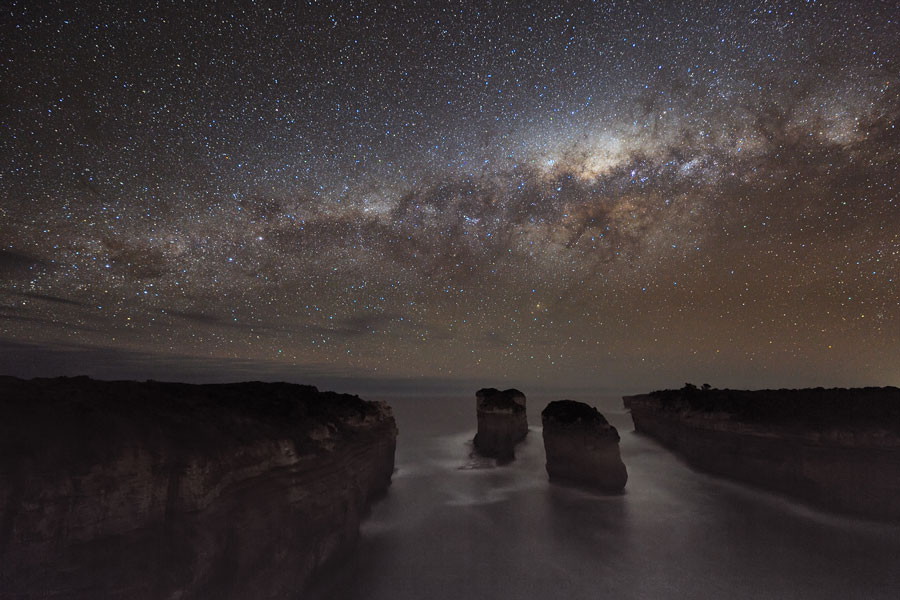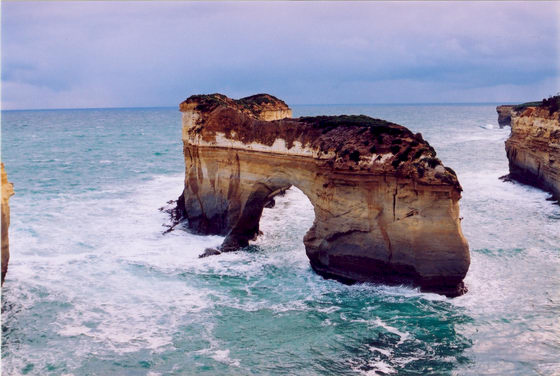 Tuesday's APOD, "A Milky Way Shadow at Loch Ard Gorge." If you look carefully at the water at the base of the two stacks on the sides toward the camera, you can see faint shadows from the "bright" Milky Way. If, of course, you're not distracted by the lovely geology. The two stacks were, until very recently, the bases on an arch, as seen in this photo from Wikipedia:
Tuesday's APOD, "A Milky Way Shadow at Loch Ard Gorge." If you look carefully at the water at the base of the two stacks on the sides toward the camera, you can see faint shadows from the "bright" Milky Way. If, of course, you're not distracted by the lovely geology. The two stacks were, until very recently, the bases on an arch, as seen in this photo from Wikipedia: The top of the arch fell in June of last year. There was an arch at the north end of Nye Beach (the site of Thursday's giant soap bubbles, though that clip was shot at the south end of the beach) until the early 90's, eroded out from a relatively thin layer of tuffaceous siltstone. The first time I saw it, in the mid 80's, it was the size of a small window. Each time I revisted, it was noticeably larger. Finally, less than ten years later, I visited and there was a stack, but no arch.
The top of the arch fell in June of last year. There was an arch at the north end of Nye Beach (the site of Thursday's giant soap bubbles, though that clip was shot at the south end of the beach) until the early 90's, eroded out from a relatively thin layer of tuffaceous siltstone. The first time I saw it, in the mid 80's, it was the size of a small window. Each time I revisted, it was noticeably larger. Finally, less than ten years later, I visited and there was a stack, but no arch. Sunday's APOD: "Hoag's Object: A Strange Ring Galaxy." Not only is this an extraordinarily beautiful object, it's the very best kind: no one has a convincing explanation for how it might have formed. One thing we can say for certain: it's not completely unique. If you look at about the 1 o'clock position inside the edge of the ring, there's another ring galaxy that looks eerily similar (queue The Twilight Zone theme music).
Sunday's APOD: "Hoag's Object: A Strange Ring Galaxy." Not only is this an extraordinarily beautiful object, it's the very best kind: no one has a convincing explanation for how it might have formed. One thing we can say for certain: it's not completely unique. If you look at about the 1 o'clock position inside the edge of the ring, there's another ring galaxy that looks eerily similar (queue The Twilight Zone theme music). As long as I'm on my much-beloved topic of astronomy+geology=teh awesome, blogger buddy Matty Boy points outs something I want to second. As I mentioned in my previous post, I'm pretty skeptical that talking to idjits is worth the time it takes, but this stupidity has been going around every August for years now. It hasn't panned out for the last six or seven rounds, and it won't pan out this time either. I received an e-mail the first go-round, but haven't since. Nevertheless, I've read news reports of scientists trying to debunk it every year for some time now. Matty's piece is one of many I've seen this year, but it was the one that made me realize I had something constructive (heh) to say about it.
As long as I'm on my much-beloved topic of astronomy+geology=teh awesome, blogger buddy Matty Boy points outs something I want to second. As I mentioned in my previous post, I'm pretty skeptical that talking to idjits is worth the time it takes, but this stupidity has been going around every August for years now. It hasn't panned out for the last six or seven rounds, and it won't pan out this time either. I received an e-mail the first go-round, but haven't since. Nevertheless, I've read news reports of scientists trying to debunk it every year for some time now. Matty's piece is one of many I've seen this year, but it was the one that made me realize I had something constructive (heh) to say about it.There is an e-mail that says Mars will look as large as the Moon some time in August. Tell your friends, tell your children and grandchildren, tattoo the dog, burn an offering and give it to the gods, big big party and you are all invited.My position is this: if this really worries you after more than half a decade of false alarms, you should know that Mars will be so close that it's gravito-magnetic field will overpower Earth's. In other words, if you look up and realize that Mars looks larger than the moon, jump off a cliff (or tall building), and you could very well be the first human on Mars! Just make sure you wait until Mars looks bigger than the moon. This may require sitting outside staring at the sky for a week or two, but imagine the wealth and fame that will come from being the first Martian! I'm not sure how you'll get back, but if you do, you'll have a free pass to all the TeeVee Tok Shows! (NB: Venus is Brighter. Be careful you don't jump until you're certain it's Mars that looks bigger than the moon. You don't want to land on Venus by mistake.)
Of course it isn't true, not even close. The math is easy. The radius of Mars is about twice the radius of the Moon, which means if they were the same distance away from the earth, Mars would look to be four times the surface area because the area is proportional to the square of the radius. If Mars was twice as far away, then the two would look to be the same size.
Mars isn't twice as far away as the moon, it's much, much farther away even at its closest. The Moon is about a quarter million miles away. At its closest, Mars is about 60 million miles away. So even when Mars is really close, the Moon is more than 200 times closer.
 Speaking of Mars and enigmatic structures, above is a crop of an image from Orcus Patera, "an enigmatic elliptical depression located between the volcanoes of Elysium Mons and Olympus Mons." (full size image; 1.4 Mb- big but very, very cool) In some respects, it resembles a crater that might result from a low-angle impactor, but it others, it seems more likely to be a volcanic caldera. It has also been suggested that it might be a hybrid of the two. Its margins have features that suggest both tensional and compressional tectonics- even in the small version above, the ~top-to-bottom (I'm not sure this is oriented with north at the top) grabens are evident.
Speaking of Mars and enigmatic structures, above is a crop of an image from Orcus Patera, "an enigmatic elliptical depression located between the volcanoes of Elysium Mons and Olympus Mons." (full size image; 1.4 Mb- big but very, very cool) In some respects, it resembles a crater that might result from a low-angle impactor, but it others, it seems more likely to be a volcanic caldera. It has also been suggested that it might be a hybrid of the two. Its margins have features that suggest both tensional and compressional tectonics- even in the small version above, the ~top-to-bottom (I'm not sure this is oriented with north at the top) grabens are evident.Pretty freaking amazing world I find myself in. And pretty freaking amazing that I can understand as much of it as I do. But I have to say, what really gets me going is when I realize how much more there still is to make sense of.










4 comments:
big and amazing
What an incredible picture of the galaxy!
@ODEUSQUERI- indeed!
@Garry- I'm not sure whether you're referring to the Milky way in the first picture, or Hoag's Object in the third, but I think they're both pretty incredible! Incidentally, I forgot to mention in the post, the second ring "inside" the first is thought to be at a much greater distance, so perspective makes it look smaller.
File this under things that knocked the breath outta me at first sight. Oh, and Hoag's Object was pretty nifty, too! Good advice on how to become the first person on Mars (but not Venus). Upshot: Best post I've read today!
And yeah, I know today's barely started, but I've been up for all four hours and forty-eight minutes of it. ;-)
Post a Comment